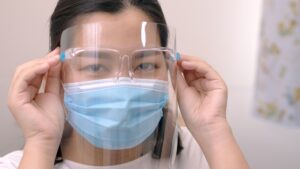
Ask the allergist is a regular feature in our newsletters where Dr. Julia Upton answers your questions!
Dr. Julia Upton is a Canadian allergist who is on staff at Toronto’s SickKids Hospital in the Immunology and Allergy Department. She is an Associate Professor in the Department of Paediatrics at the University of Toronto and is the past Section Chair of Food Allergy and Anaphylaxis with the CSACI. Dr. Upton is also a member of our Healthcare Advisory Board.
Please note: Dr. Upton is answering as an individual allergist and her answers do not constitute an official position of her affiliated organizations. Her responses are for informational purposes only and do not constitute specific medical advice, recommendations, diagnosis, or treatment. Please talk to your doctor about any concerns or questions you may have regarding your own health or the health of your child.
This month she answers questions about face masks and the inhalation of airborne proteins, and on wearing face shields.
Does a face mask offer someone with food allergy any protection from inhaling airborne proteins?
Inhaling food proteins is a rare way to experience a food allergen. The protein in a food causes a reaction, and one example is inhaling protein through the steam produced by cooking fish. Smelling a food allergen, such as peanut butter, is different as the odour does not involve food proteins.
Therefore, if you are being exposed to inhaling food particles this is an unusual situation. How to reduce this risk is best discussed individually with your allergist. The effectiveness of the face mask in protecting from inhaling proteins will depend on the size of the particles in the air and the style/type of mask.
Managing the risk of accidentally eating your food allergen is the most important focus. Wiping down surfaces and washing hands before eating and food preparation are recommended measures for helping to reduce accidental exposure.

I wonder about face masks making allergic symptoms harder to recognize. If someone has a food allergy, is it better to wear a face shield?
Masks for COVID-19 precautions are taken off when eating and skin will be visible during this time. An allergic reaction can happen after the mask is put back on, covering up skin symptoms on the face. Anaphylaxis generally includes two or more body systems, which means that a person most likely will have other symptoms beyond the skin covered by the mask, such as hives or itching on other parts of the body, or symptoms related to breathing, the stomach or heart.
Given that meal and snack times are the most likely occasions to have exposure to food allergens (when masks are not worn), reactions typically happen within minutes of exposure, and there are symptoms of anaphylaxis not involving the skin, I would recommend people use whichever face covering they prefer.
Do you have a question you’d like to ask Dr. Upton in the months to come? If so, please send it along to us at info@foodallergycanada.ca. Please note: Dr. Upton answers questions on general topics, please talk to your doctor if you have questions about your own health or the health of your child.
Tags: ask the allergist, Ask the expert, dr. julia upton